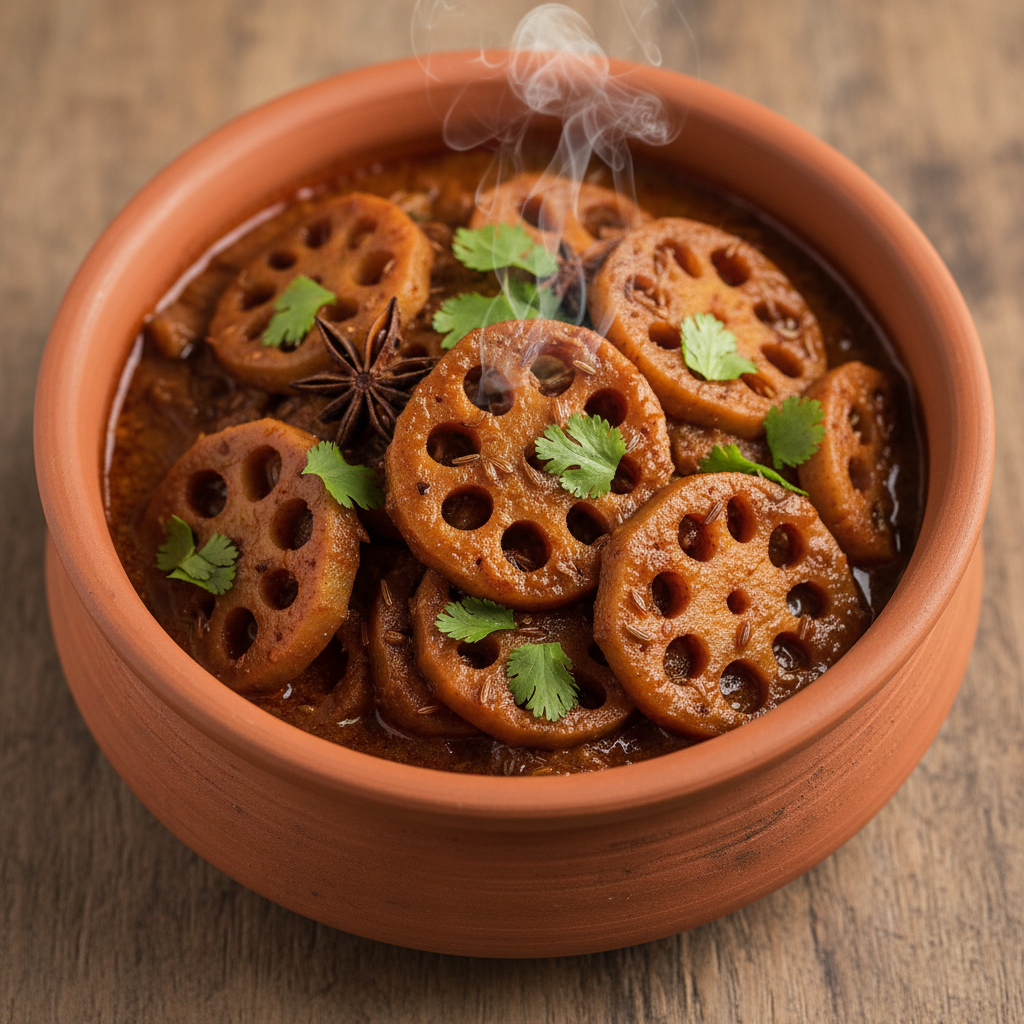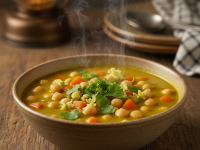Hey there, fellow food adventurers! Have you ever stumbled upon an ingredient that completely redefines your culinary boundaries? For me, that ingredient was the humble, yet utterly fascinating, lotus stem. When I first encountered it, I admit, I was a bit skeptical. A plant that grows in mud, looks like a series of hollow tubes, and has a rather unassuming appearance? My initial thought was, “Can this really be delicious?” Oh, how wrong I was!
My journey with lotus stem began years ago during a trip where I tried a regional specialty – a deep, rich curry featuring this intriguing vegetable. The crunch, the tenderness, the way it soaked up all the aromatic spices… it was a revelation! Since then, I’ve been on a mission to recreate and perfect my own version of this exotic, plant-based delight right in my kitchen. And let me tell you, it’s become a firm family favorite, a dish that often surprises guests, and always leaves everyone asking for the recipe. So, get ready, because today I’m going to share my perfected lotus stem curry recipe, along with all my tips and tricks, so you can experience this unique flavor journey too!
What Exactly is Lotus Stem and Why Cook With It?
Before we dive into the deliciousness, let’s talk a little about our star ingredient: the lotus stem, also known as lotus root or “kamal kakdi” in Hindi. It’s not actually a stem, but rather the rhizome of the lotus plant, which grows submerged in water. Visually, it’s quite distinctive, with its long, tubular shape and characteristic hollow air chaels that form a beautiful pattern when sliced.
So, why should you bother with it? Well, for starters, its texture is absolutely unique. When cooked properly, it offers a delightful balance of crispness and tenderness. It’s not mushy, not fibrous, but has a satisfying bite that stands up beautifully in a curry. But beyond the texture, lotus stem is a fantastic canvas for flavors. It’s incredibly porous, meaning it acts like a sponge, soaking up all the rich spices and aromatics of your curry base, making every mouthful a burst of flavor.
From a nutritional standpoint, it’s a wier too! Lotus stem is packed with dietary fiber, which is great for digestion, and it contains a good amount of Vitamin C, B vitamins, and essential minerals like iron and potassium. Plus, it’s naturally low in calories. For anyone looking to explore new plant-based ingredients or add more unique vegetables to their diet, lotus stem is an absolute gem. I remember the first time I bought it from an ethnic grocery store, feeling a little intimidated. But once I got it home and started experimenting, I realized its potential. It’s truly a versatile and rewarding ingredient to cook with.
My First Foray: Learning the Ropes (and the Prep!)
Okay, let’s be honest, prepping lotus stem can seem a bit daunting at first. It comes covered in a muddy skin, and those characteristic hollows can sometimes hide dirt. My initial attempts involved a lot of scrubbing and guesswork! But through trial and error, I’ve developed a super efficient system.
The most crucial step is cleaning. You need to thoroughly wash the lotus stems under ruing water, scrubbing off any mud. I often use a vegetable brush for this. Then comes peeling. A regular vegetable peeler works wonders. Once peeled, you’ll want to trim off the ends. Now, for the slicing: I prefer to slice them into roughly ½-inch thick rounds. This thickness allows them to cook through nicely while still retaining their unique texture.
Here’s my absolute game-changer tip: After slicing, immediately soak the pieces in cold water, sometimes with a splash of vinegar or lemon juice, to prevent discoloration. And before adding them to your curry, always blanch or par-boil them. This isn’t just about making them tender; it also helps to get rid of any faint earthy taste and ensures they’re perfectly soft yet still have that desirable slight bite in the final dish. I usually boil them in salted water for about 10-15 minutes, or until they are fork-tender but not mushy. Drain them well, and they’re ready for their starring role!
The Heart of the Dish: Crafting the Curry Base
The magic of any good curry lies in its base, and this lotus stem curry is no exception. Over the years, I’ve experimented with various spice combinations and aromatic foundations. My current perfected version balances warmth, tang, and a hint of sweetness, creating a truly rich and comforting flavor profile.
We start with the holy trinity of Indian cooking: finely chopped onions, ginger, and garlic. Getting these golden and fragrant is key. This step isn’t just about cooking them; it’s about building the first layer of deep flavor. I learned early on that patience here pays off – don’t rush the caramelization of the onions!
Next come the ground spices: cumin powder, coriander powder, turmeric, red chili powder (adjust to your spice preference!), and a good dose of garam masala. I always toast my whole spices lightly before grinding them, or at least use fresh, good-quality ground spices. The aroma that fills your kitchen at this stage is absolutely intoxicating. It’s a moment where you know something delicious is about to happen.
For the richness and body of the gravy, I’ve settled on a combination of pureed tomatoes and a touch of yogurt (or coconut milk for a completely vegan version). The tomatoes provide a lovely tang and depth, while the yogurt adds a creamy texture and subtle sourness that beautifully complements the spices. If using yogurt, make sure it’s plain and whisked well to prevent it from curdling when added to the hot pan. I’ve found that adding a little water to the yogurt before mixing it in helps too. This balance of acidity and creaminess is what really elevates the curry, giving it that restaurant-quality finish.
Bringing it All Together: The Lotus Stem & The Simmer
Once your curry base is fragrant and bubbling, it’s time for our star, the blanched lotus stem, to make its grand entrance. Gently fold the lotus stem pieces into the prepared masala. At this point, I like to let them coat in the spices for a few minutes, stirring occasionally, allowing those wonderful flavors to really start permeating the pores of the lotus stem.
Now, for the simmer. This is where the magic truly happens. Add enough water or vegetable broth to achieve your desired gravy consistency – I prefer a medium-thick gravy that clings to the lotus stem. Bring it to a gentle simmer, then reduce the heat, cover the pan, and let it cook slowly for at least 15-20 minutes. This slow simmer is crucial; it gives the lotus stem ample time to fully absorb all the intricate flavors of the curry, making it incredibly tender and flavorful without losing its signature bite.
During this simmering phase, I often sneak in my little “secret ingredient” that truly rounds out the flavors: a pinch of dried fenugreek leaves (kasuri methi), gently crushed between my palms before adding. It imparts a subtle, earthy aroma that is just divine. Towards the end, taste and adjust the seasoning. Does it need more salt? A squeeze of lime juice for brightness? A tiny pinch of sugar to balance the tang? This is your curry, so make it perfect for your palate!
Serving Suggestions & Why This Curry Steals the Show
When my lotus stem curry is ready, glistening with rich gravy and aromatic steam, I can hardly wait to dig in. The vibrant colors and the incredible aroma fill the kitchen, promising a truly satisfying meal.
This curry is wonderfully versatile in how it can be served. My personal favorite is with warm, fluffy basmati rice, allowing the rice to soak up every drop of that luscious gravy. But it’s equally fantastic with fresh, soft naan bread, hot rotis, or even a simple homemade paratha. A sprinkle of fresh coriander leaves right before serving adds a burst of freshness and a beautiful green contrast to the rich, reddish-brown curry.
What truly makes this curry steal the show is the unique experience it offers. The lotus stem itself is a conversation starter – its delicate crunch combined with the tender interior, all infused with complex spices, creates a textural and flavor journey unlike any other vegetable. It’s exotic yet comforting, plant-based yet incredibly hearty, and always leaves a lasting impression. It’s more than just a dish; it’s an invitation to explore new flavors and expand your culinary horizons. So, are you ready to embark on this delicious adventure?
The Recipe: My Go-To Lotus Stem Curry
Ingredients:
- 2 medium lotus stems (about 500g), peeled and sliced ½-inch thick
- 1 large onion, finely chopped
- 2 large tomatoes, pureed (or 1 cup caed crushed tomatoes)
- 1/2 cup plain yogurt (or full-fat coconut milk for vegan)
- 2 tbsp ginger-garlic paste
- 1-2 green chilies, slit (adjust to taste)
- 3 tbsp cooking oil (vegetable or any neutral oil)
- 1 tsp cumin seeds
- 1/2 tsp asafoetida (hing – optional, but highly recommended for digestion and flavor)
- 1 tsp turmeric powder
- 1.5 tbsp coriander powder
- 1 tsp red chili powder (or Kashmiri chili powder for color, less heat)
- 1 tsp garam masala
- 1/2 tsp dried fenugreek leaves (kasuri methi), crushed
- Salt to taste
- 1.5 – 2 cups hot water or vegetable broth (adjust as needed)
- Fresh coriander leaves, chopped, for garnish
- Optional: A squeeze of fresh lime juice at the end
Instructions:
- Prepare the Lotus Stem: Wash the peeled and sliced lotus stem pieces thoroughly. In a pot, bring salted water to a boil. Add the lotus stem pieces and boil for 10-15 minutes, or until fork-tender but still firm. Drain and set aside.
- Sauté Aromatics: Heat oil in a heavy-bottomed pot or Dutch oven over medium heat. Add cumin seeds and let them splutter. Add asafoetida (if using).
- Build the Base: Add chopped onions and sauté until golden brown, stirring frequently. This might take 8-10 minutes – patience here is key for deep flavor.
- Add Ginger-Garlic & Chilies: Add ginger-garlic paste and green chilies. Sauté for 1-2 minutes until the raw smell disappears.
- Incorporate Spices: Reduce heat to low. Add turmeric powder, coriander powder, and red chili powder. Stir for 30 seconds until fragrant, being careful not to burn the spices. If the mixture seems too dry, add a tablespoon of water.
- Add Tomatoes & Yogurt: Stir in the tomato puree. Cook, stirring occasionally, until the oil separates from the masala (about 5-7 minutes). If using yogurt, whisk it well and then gradually add it to the simmering masala, stirring continuously to prevent curdling. Cook for another 2-3 minutes until the oil separates again. (If using coconut milk, add it after the tomatoes have cooked down and simmer for a few minutes.)
- Introduce Lotus Stem: Add the blanched lotus stem pieces to the curry base. Stir gently to coat them evenly with the masala.
- Simmer to Perfection: Pour in 1.5 – 2 cups of hot water or vegetable broth. Bring the curry to a gentle simmer. Add salt to taste. Cover the pot and let it cook on low heat for 15-20 minutes, allowing the lotus stem to absorb all the flavors.
- Final Touches: Stir in garam masala and crushed kasuri methi. Cook for another 2 minutes. Taste and adjust seasoning. If desired, add a squeeze of fresh lime juice for brightness.
- Serve: Garnish generously with fresh coriander leaves. Serve hot with rice, naan, or roti.
Chef’s Notes & Tips:
- Cleaning is Key: Don’t rush the washing and peeling. Mud can hide in the crevices!
- Par-boiling: Crucial for tenderness and removing any earthy notes. Don’t skip it.
- Spice Level: Adjust red chili powder and green chilies to your preferred heat.
- Vegan Option: Replace yogurt with full-fat coconut milk for a rich, dairy-free curry.
- Storage: Lotus stem curry tastes even better the next day as flavors deepen. Store in an airtight container in the refrigerator for up to 3-4 days.
Conclusion
And there you have it! My absolute favorite lotus stem curry recipe. It’s a dish that takes a little effort in the preparation, but the rewards are immense. The unique texture of the lotus stem, combined with the deeply aromatic and flavorful curry, creates a truly memorable meal. It’s a fantastic way to introduce an exotic vegetable into your culinary repertoire and impress your family and friends with something delightfully different. So, take a leap of faith, gather your ingredients, and give this incredible plant-based curry a try. I promise you, it’s a journey your taste buds will thank you for!




